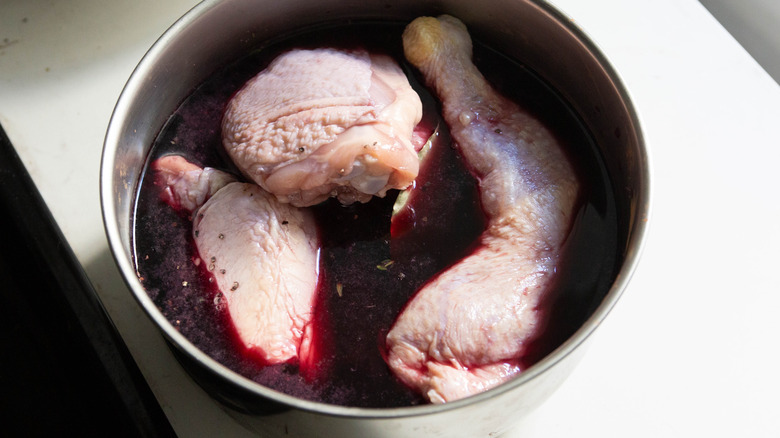The Fascinating Science Behind Coq Au Vin
One of France's best-known dishes, there's more to coq au vin than just dumping some wine onto some chicken and cooking it. There are a few different chemical processes going on that transform the base ingredients (chicken, wine, mushrooms, onion, bacon) into something truly sublime.
Technically and historically speaking, coq au vin isn't made with just any chicken — it's traditionally made with rooster ("coq" in French), which, when farmed, would usually yield tougher meat that needs some tenderization. (Modern-day recipes usually just call for regular chicken, as rooster meat isn't all that common in grocery stores and butcher shops.) The wine (ideally a full-bodied red, says Julia Child) is absolutely key to getting that tenderization. This still applies even if you're using regular, less-tough chicken, although you can get away with braising your meat for a shorter time period.
The acid from wine is essential for breaking down the protein structures in tougher chicken (or rooster) meat in a process called denaturing, where long protein strands are effectively broken up. (This is why if you marinate chicken in wine or another acid for a really long period like two days, it will turn to mush.) On top of that, because some of the wine's liquid is cooked off, its flavors get more concentrated and merge with the chicken, giving it both a luscious red-tinted color and that complex layered taste with sweet and tangy notes.
Coq au vin also features Maillard reactions and caramelization
While the wine in coq au vin unlocks much of the dish's flavor, there are other scientific processes that can add even more depth and richness to the dish. First up is the Maillard reaction: This process isn't isolated to coq au vin, as it occurs in a lot of dishes that are cooked with heat. It's a series of small chemical reactions that occur between proteins and sugars in meats, vegetables, and other ingredients. A mixture of heat and the right amount of moisture prompts these molecules to rearrange themselves into new constellations that most people find extremely tasty and appealing.
When this has occurred, foods will usually start browning in color — and this is exactly why good coq au vin recipes should instruct you to brown the chicken before you start adding wine. High heat is important for this — if it's too low, the Maillard reaction won't occur, which is why boiled meat won't display this browning. You can also do it with the bacon to get a double-whammy of this tasty reaction (and save the fat to brown the chicken right after).
Finally, there's caramelization. Like the Maillard reaction, caramelization also yields complex flavors, but it occurs mostly from sugars breaking down. This means it usually works best with ingredients that contain some sugars, and onions are a great candidate here. So, you should caramelize the onions for your coq au vin on low heat for a nuanced hint of sweetness. With all these scientific processes at work in your coq au vin, the results will be deliciously complex.

